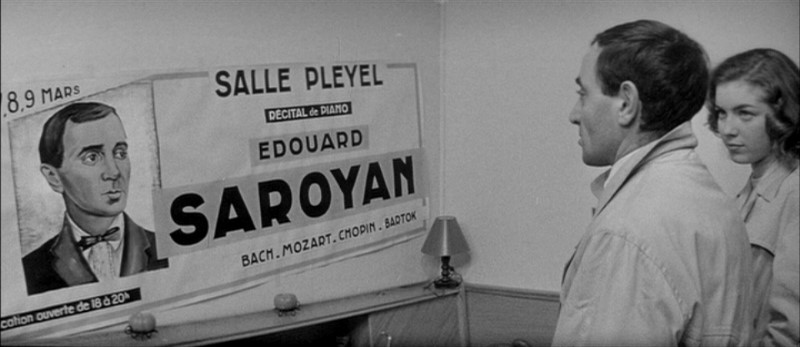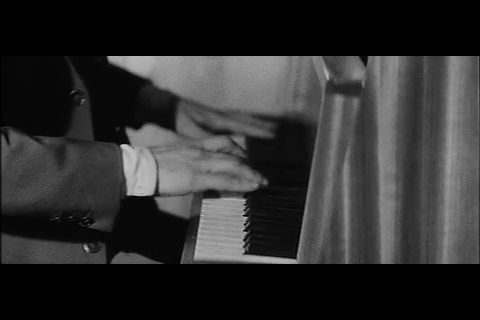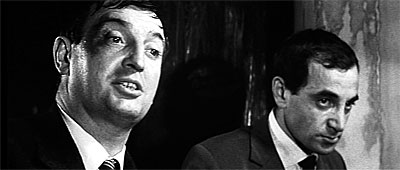This was written in the summer of 2000 for a coffee-table book edited by Geoff Andrew that was published the following year, Film: The Critics’ Choice (New York: Billboard Books). — J.R.

Considering how romantic it is, how sad and funny and charming, it is a sobering fact that François Truffaut’s second feature –- and the first one that qualifies as a quintessential New Wave expression — was a disaster at the boxoffice. Indeed, if this eccentric adaptation of David Goddis’s 1956 crime novel Down There illustrated any general commercial principle, this may be that one subverts overall genre expectations at one’s peril. For Tirez sur le pianiste is a film noir that literally turns white (through such images as piano keys or a snowy hillside) when the plot is at its darkest, and one that sometimes interrupts the viewer’s laughter with a disquieting catch in the throat.



The opening sequence already sends out bewildering crossed signals. A man fleeing in panic through dark city streets at night collides with a streetlight, then finds himself talking quite calmly with a sympathetic stranger –- a character who exits the movie immediately thereafter -– about the latter’s love for his wife. Moreover, while the fluid and flexible black-and-white cinematography (by Raoul Coutard) is in the anamorphic process Dyaliscope, the ambience is cramped and cozy in the best low-budget tradition. Read more
This was written in the summer of 2000 for a coffee-table book edited by Geoff Andrew that was published the following year, Film: The Critics’ Choice (New York: Billboard Books). — J.R.

Apart from his scandalous Salò, or the 120 days of Sodom, 1975 -– another film with spiritually induced levitation -– this shocking 1968 feature, Pier Paolo Pasolini’s last film with a contemporary setting, may be his most controversial work, displaying the kind of audacity and excesses that send some audiences into gales of defensive, self-protective laughter. (For a contemporary near-equivalent, think of Bruno Dumont’s 1999 film L’Humanité.)

The “theorem” of the title is a mythological figure whose arrival is heralded by Pasolini’s favorite fetish-actor, Ninetto Davoli, bringing a telegram to the home of an industrialist (Massimo Girotti). An attractive young man in tight-fitting trousers (Terence Stamp) then pays an extended visit, proceeding with solicitous devotion to seduce every member of the household — father, mother (Silvana Mangano), teenage daughter (Anne Wiazemsky), somewhat older son (Andrès José Crux), and maid (Laura Betti) — to the recurring strains of Mozart’s Requiem Mass and a modernist score by Ennio Morricone.



Then the stranger leaves as mysteriously as he came, and everyone in the household undergoes cataclysmic and traumatic changes. Read more
From the September-October 1995 issue of Film Comment. I should stress that this essay is very much out of date once one starts to consider Cozarinsky’s prolific subsequent career as both a writer and a filmmaker — although I’ve anachronistically included a few more recent book covers and film posters as illustrations, as well as a poster and two stills from his most commercially successful film to date, the 2005 Ronda Nocturna, known in English as Night Watch, in part to help make up for the impossibility of finding stills for some of the rarer films of his discussed here.
Let me also quote my Reader capsule review of Night Watch: “With a few exceptions, I prefer the literature of Edgardo Cozarinsky, an Argentinean based mainly in Paris, to his films, and his nonfiction in both realms to his fiction. But this poetic, atmospheric drama, shot in Buenos Aires, challenged my bias, mixing the natural and the supernatural, the cinematic and the literary, with such assurance that Cozarinsky no longer seems like a divided artist. Following a teenage street hustler through the night of All Saints’ Day, he turns a documentary about his hometown and its street life into a haunting piece of magical realism. Read more









